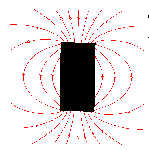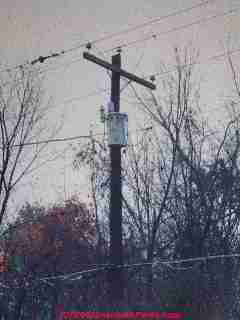
Definitions of Terms for RF and EF Electromagnetic Fields
Table of Electromagnetic Radiation Frequencies by Type of Source
Definitions & table of signal & other frequencies from lowest to highest:
This article defines and explains electromagnetic field (EMF) or electromagnetic radiation EMR and related terms such as EMF, radio frequency - RF, hertz or cycles, megahertz, medium frequency MF, very high frequency VHF, ultra high frequency UHF, megahertz MHz, gigahertz GHz, terahertz THz .
Before buying test equipment to measure the strength of electromagnetic fields, readers should review this article to be sure that they understand the types of electrical fields that exist, the typical sources of different types of electromagnetic fields (power lines, AM and FM radio towers, cell towers, other equipment), and thus the type of test equipment that would be used to assess electrical field strength.
Discussed here: What kinds of radio frequency waves are there, what are EMF, RF, hertz, megahertz, MF, VHF, UHF, MHz, GHz, THz ? Definition of ELF EMF VHF UHF - Definitions of electromagnetic frequency ranges & electromagnetic radiation types & sources.
Table of Electromagnetic Radiation Frequencies by Wavelength and Frequency - Table of electromagnetic fields by source type: cell towers, cell phones, power lines, radio towers, home appliances, CRTs, computers, etc. Links to EMF measurement explanations, procedures, worksheets, instruments & advice.
Electromagnetic fields, or EMFs are invisible lines of force created whenever electricity is generated or used. EMFs are produced by power lines, electric wiring, and electric equipment and appliances. The frequency of EMFs is measured in hertz (Hz, or cycles per second).
People are exposed to both electric and magnetic fields, but scientists are most concerned about magnetic fields. This fact sheet deals only with magnetic fields that have frequencies near 60 Hz the frequency of electric power in North America.
Static magnetic field around a bar magnet.
Health professionals, epidemiological experts, and in the case of EMF, electrical engineers can offer competent, expert advice which should be considered before any costly or risky actions are taken regarding this or other environmental topics. Use information at this website at your own risk.
Here are simple definitions of terms that you should know if you are concerned with RF or EMF hazards and where they might originate, or how they might be measured
Here we provide a summary of EMF, EMR, and radio frequency cycle rates, and where they are used. Our definitions are arranged in order of increasing frequency or decreasing wavelength of electromagnetic signals.
Hertz - is defined as cycles per second and synonymous with low frequency - example: 60 Hz - 60 cycles per second is the typical power line distribution EMF frequency in the U.S. One Hz = one cycle per second.
Medium Frequency (MF) - is defined as thousands of cycles per second - example (530kHz to 1600 kHz) - typical AM radio frequency (your car radio) in thousands of cycles per second.
Very-high VHF and ultra high UHF frequency is defined as millions of cycles per second - example FM radio, television, digital television, in the MHz range: Megahertz - MHz -
millions of cycles or 1,000,000 cycles per second
NTSC - analog TV used in most of North America and other countries we're looking in the 1MHz frequency and higher range.
Typically in the 6 to 8 MHz range. TV signals in this frequency range are widespread in North America, and easily penetrate building walls and ceilings.
Extremely high frequency - EHF is defined as billions of cycles per second, and is the highest radio frequency band, extending from 30 to 300 GHz. or in wavelength size, waves are 1-10 mm or millimeters, also abbreviated MMW or mmW.
Microwaves are an example.
Microwaves range from 1mm to 1 meter in wavelength, or in a frequency equivalent, from 300 MHz (0.3 GHz) TO 300 GHz. Example: Satellite GPS signals are in this much higher gigahertz range: 1.575 GHz range (easily attenuated by building walls).
Microwave ovens operate in this frequency range when heating food.
Microwaves - is often used in the media as a rather a broad term that encompasses radio or electromagnetic frequencies from roughly 300MHz (300 million waves per second - .1m to 1m in length) to 3GHz (3 billion waves per second - .001 m to 1m in length).
Gigahertz - GHz is defined as billions of cycles per second - 1000 x more than mega, or 1,000,000,000 cycles per second - Microwave towers, UHF and EHF transmission - operate in the 1GHz to 100GHz range.
Terahertz - THz is defined as trillions of cycles per second- Wavelengths at frequencies still higher than EHF - GHz are referred to as Terahertz radiation, but are more familiarly understood as infrared light.
Still higher frequencies become light visible to the human eye.
One THz is a very high frequency unit of electromagnetic (EM) wave frequency equal to one trillion hertz (10-to-the-12th power Hz) - see our table comparing all of the common Hertz frequency ranges found



